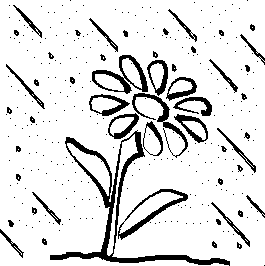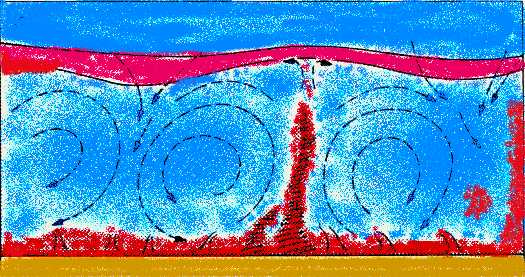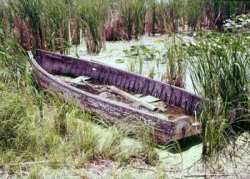 |
 |
| Home | Welcome | What's New | Site Map | Glossary | Weather Doctor Amazon Store | Book Store | Accolades | Email Us |
 | |||||||||
Weather Almanac for April 1999APRIL SHOWERSApril showers bring May flowers.
So the old saying goes. As I sit here at the computer, wrens and house sparrows and a collection of other birds in the distance are singing their territorial or mating songs. The morning dawned just before I awoke so I did not see the dawn sky, but as I write, the sky is fittingly a robin's-egg blue with cauliflower edges and just the hint of a breeze. Yesterday dawned in a similar fashion, but by mid-afternoon the cauliflower rim began to congeal overhead and the temper of the sky changed. No longer a lovely blue, the sky's colour dulled to shades of grey and blue-grey and dirty white. Then I heard it. At first a tip-tap on my bicycle tarp, then pitter-pat and finally, as the day drew darkly around me, a steady whoosh of sky tears. For ten to fifteen minutes, the distant buildings and trees disappeared behind the aqueous curtain. And then, as quickly as it had exited, the sun's light burst forth, reflecting in multicoloured hues from the oil-water melange on the pavement below. It was: a shower...an April shower... a common form of precipitation here amongst the mountains of the Pacific Coast. But showers are also very common during April across most of North America. And in this month, they can often be snow showers as well as rain showers, particularly in Canada and the northern tier of States. Showers are a distinct form of the fall of precipitation, rain or snow. The accepted technical definition for shower is: precipitation falling from a convective cloud, characterized by the suddenness with which it starts and stops, by rapid changes of intensity and usually rapid changes in the appearance of the sky. The keys here are falling from a convective cloud and suddenness. Showers are not generally associated with those large-scale storms which dominate winter precipitation when precipitation usually falls steadily from stratiform clouds surrounding the low pressure cell. However, in areas such as the Great Lakes Basin, much snow may fall as snow showers or snow squalls in the cold air before or after the storm system when convective clouds boil up as the cold air crosses relatively warm waters. Forming April ShowersApril showers are more than just a poetic choice of words to rhyme with flowers. You see, April is a transitional month in much of North America in the character of precipitation. Over much of the continent, the vigorous cyclonic activity of winter is on the wane and steady frontal rains are becoming less frequent. From now until late in the autumn, much of the rain falling across the continent will come from convective clouds. Again the sky closes around us, and before pedestrians can open their umbrellas, the next line of showers drenches the neighbourhood. And again, true to cycle, the rains end within ten minutes. A house sparrow hops to my balcony railing and cheeps an "All Clear!" The warm spring sun returns to dry the pavement of all evidence of the passing shower. In April, the upper atmosphere still retains much of the winter's cold temperatures, but below the earth's surface is nearly bare of snow and likely very moist. This allows the sun's growing heat (note that April is the last month of solar spring) to evaporate moisture from the soil and also significantly warm the air adjacent to the surface. Warming air below and cold air above results in the rapid rise of warm bubbles of moist air, each bubble generally capped with a cumulus cloud as soon as it reaches the condensation level.  If the conditions are right, these bubbles grow into larger clouds which form, at first, small raindrops in the ascending air. When the updrafts are strong, the drops will grow to larger sizes. Eventually, either the updraft collapses when the air is no longer sufficiently warm to continue rising, or the drops become too heavy for the updraft to support, and they fall to earth as rain. Because the updraft collapse can be sudden, the onset of rain is also sudden, thus giving the precipitation its showery character.
When moist air is forced over a physical barrier such as mountains or large hills, updrafts are also formed. Once the air reaches the condensation level, liquid water will collect in the clouds. After the clouds have been forced over the barrier summits, the supporting updrafts are cut and as the air descends, some of the liquid falls as showers in the lee of the barrier, the remainder evaporates. Such is the character of much of the rain that falls in the Pacific Northwest during the spring. April showers are generally less severe than summer showers. In high summer, the warm ground quickly heats and forms very large warm air bubbles which are capable of reaching high into the atmosphere. The product of the larger convective cells is usually a thundershower or thunderstorm. Indeed, the added warmth of the air allows summer showers to be much heavier than those in April because of the greater water vapour content of the air. For example, if we take cool, saturated air, let us say at 4 °C (40 °F), and cool it 5.5 C deg (10 F deg) to -1 °C (30 °F), approximately 2 grams of liquid water will condense out per cubic metre. However, if that saturated air was at 21 °C (70 °F) and cooled by the same amount (to 16 °C or 60 °F), 5 grams of liquid water will condense out per cubic metre -- over twice as much to fall to the surface as rain than in the cooler air. Thus, April showers tend to be gentler falls of rain than their June or July counterparts. And what better way to promote the emergence of the flowers of May. Seed and seedling are caressed by the life-giving rain, not washed out by strong deluge. And given proper growing conditions, the seeds will set and mature, ready to blossom in May and later months. Late afternoon presents what proves to be the last freckling of showers this day. As the light rain ends, a short 5-minute encore, the falling solar orb tints the cloud margins in golds and crimsons. I sit, watching, nursing a cup of tea, as the last of the day's entertainment exits Stage East. Learn More About Rain From These Relevant Books
|
|||||||||
 |
To Purchase Notecard, |
Now Available! Order Today! | |
 |
 |
NEW! Now |
The BC Weather Book: |


